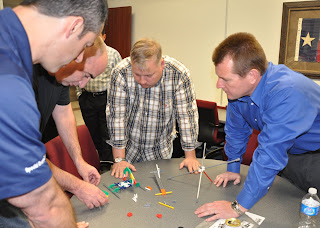 Law enforcement officers test the dirty dozen of human error in a timed exercise building a model helicopter.
Law enforcement officers test the dirty dozen of human error in a timed exercise building a model helicopter.To better prepare law enforcement for infrequent, high-risk situations, such as hot pursuits, use of force or felony car stops, the Law Enforcement Management Institute of Texas (LEMIT) at Sam Houston State University's Criminal Justice Center hosted a training to identify common human errors and how to avoid them as officers and agencies.
“In the error chain, there is a series of events and if you can identify any link in the chain and break it, the accident or incident won’t happen,” said Steven M. Ghidoni of Integrated Training & Performance Solutions.
The program, Human Judgment Interference Factors Initiatives, is based on tools developed to investigate the human factors in aviation accidents and to prevent future incidents. Human Factor Awareness Training is used in several fields, including aviation, medical and engineering, and has been adapted to law enforcement in instances where lives depend on performance.
 Instructor Steven Ghidoni explains the human error factors from lessons learned from an LA commuter train crash. “LEMIT's main goal in offering this training is for an improvement in safety,” said Mikal Sieger, Special Program Coordinator at LEMIT. “Awareness of Judgment Interference Factors allows for a pro-active action to prevent a hazardous situation from occurring.”
Instructor Steven Ghidoni explains the human error factors from lessons learned from an LA commuter train crash. “LEMIT's main goal in offering this training is for an improvement in safety,” said Mikal Sieger, Special Program Coordinator at LEMIT. “Awareness of Judgment Interference Factors allows for a pro-active action to prevent a hazardous situation from occurring.”
The training will help law enforcement officers to identify policies or procedures that may increase the potential for mistakes and to review performance processes to minimize errors and to improve practices. The program was presented by the Missouri-Regional Community Policing Institute and funded by the federal Bureau of Justice.
“What we are doing is applying human judgment interference mitigation to high risk, low-frequency, no discretionary time incidents,” said Bryan Courtney, Director of the Regional Community Police Institute at Missouri Western State University. “We are hoping that officers and agencies will understand that human judgment interference factor review of incidents can assist in explaining an officer's actions and if human judgment interference played a role in the actions. The overall goal is to give officers the tools to identify and mitigate human judgment interference factors that link the tasks of law enforcement to: complaints, litigation, loss of community trust and support, internal cynicism, damage and destruction of equipment and resources, and catastrophes."
The program discussed key factors attributed to human error, known as the Dirty Dozen, and the safety nets individuals or organizations can use to address them. Among these are:
- Lack of communication, including written, verbal and other. Approved processes should be used consistently and communicated to officers in the agency.
- Complacency, caused by repetitive behavior. There is a need for high standards of performance and training on updated procedures and methods.
- Lack of knowledge, particularly when a new change is implemented. Train all offers on new equipment, policies and procedure and allow officers to ask questions when in doubt. Officers also can ask co-workers for advice.
- Distractions. Because of the increasing technology in patrol cars and in personal devices, computers should only be used when the patrol car is stopped, and non-essential items should be stowed away. Partners, when available, can be utilized to perform tasks when they are not driving.
- Lack of teamwork during times of stress, fatigue or distraction. Officers should discuss what needs to be done, who will do the tasks and how the project will be completed. Feedback should be solicited on assignments to make sure everyone on the teams agrees on their roles and responsibilities.
- Fatigue, which can be caused by such things as prolonged exposure to extreme temperature, stress, smoking, being overweight or disorganization. It is important to be aware of the symptoms of fatigue and for officers to get adequate sleep and exercise. Officers also can rely on a buddy system to watch out for each other.
- Lack of resources. Resource issues need to be addressed when they jeopardizes safety and unapproved equipment should not be used as a substitute. Before tackling critical assignment, officers should ensure that they have the proper equipment and personnel to handle the job.
- Pressure. Guard against self-induced pressure, communicate concerns over issue, and be respectively assert in conflicts or tasks when overwhelmed.
- Lack of assertiveness. Officers should establish relationship based on trust and honest feedback and not compromise their safety or ethical standards.
- Stress. Be aware of signs of stress and look at rational solutions, such as taking time off or a break, exercising, or asking fellow officers to monitor performance.
- Lack of Awareness. Officers need to be mindful not only of the current situation, but the future consequences of their actions.
- Norms are group rules that establish appropriate and/or inappropriate values, beliefs, attitudes, and behaviors. Norms are not always detrimental. With proper recognition and processing norms can be used to implement positive changes.
The Human Judgment Interference Factors Program is one of the special programs offered by LEMIT, which provides leadership and management trainings to law enforcement officials throughout Texas. The special programs are designed to convey innovative concepts, techniques and knowledge that can quickly be put into practical use within an agency.